Mary, the mother of Jesus, seems to hold a tough position in Mormon iconography. We honor her for her role in bearing and raising Jesus, and we celebrate her in art of the Nativity and closely related stories (the Annunciation, the Flight into Egypt, the boy Jesus at the temple). We’re also comfortable with images of Mary at the crucifixion. We even use the idea of Mary to celebrate Mormon motherhood, as in the gallery of images in the December 2007 Ensign, A Mother and an Overflowing Heart.
But with the exception of the “Jesus Praying with His Mother” picture in the Church’s new Gospel Art Book — which image strikes me as a little forced, for some reason; maybe a reader can explain why — our images of Mary are tied very closely to the Biblical narrative. In modern times, we don’t seem to see many portraits of Mary that celebrate Mary as a woman and/or a mother, apart from specific New Testament stories. Why is that? Are such portraits “too Catholic”? Too closely tied to crucifixes and statues? Did we perhaps pull away from Mary as Madonna as part of that whole hypersensitivity toward angels-with-wings and crosses-as-jewelry of the Joseph Fielding Smith era?
If that’s the case — and maybe it is only a personal perception — we haven’t always been shy of Mary portraiture. Madonnas from the great masters appeared on the covers of many Church magazines of the past, especially the Relief Society Magazine. I posted several of those covers during the Christmas season last year (links to those covers are provided at the bottom of this post).
And last week I discovered that in 1925, the Young Woman’s Journal featured a different Madonna in each monthly issue, accompanied by text written by Lutie H. Fryer, an LDS professor at the University of Utah who taught home economics, interior decoration, and fine arts at various times in her career. I find the text a little overwrought, unhelpful in its superlatives and its gushing praise of the meaning of every tilted chin or soulful eye. Yet she chose some exceptionally lovely Madonnas, from different traditions and eras. The monthly feature evidences a real desire to have the Latter-day Saint girls and young women of that era become familiar with great art of a worthy subject, even though the reproductions were in black and white and sometimes rather poor engravings of the originals.
Below are the Madonnas that appeared in those 1925 Journals, along with a sampling of the less-burbling parts of the texts. Because we’re spoiled and have little patience with black and white reproductions, I’ve also included color scans of the original paintings. The quality differences make me sad for the young women of 1925, since it seems likely that these images are the only versions most would have been able to view. On the other hand, that the magazine would devote such space to a recurring feature suggests how important the editors thought it was for the young women to be exposed to the images of Mary, in their “Little Study of Madonnas.” That, I like.
.

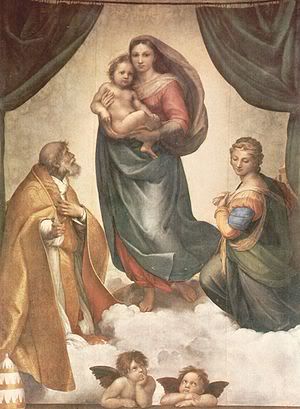
.
.
.
.
.
.
.
.
.
.
.
Sistine Madonna - Raphael
“Against the dim background, with its suggestion of a spiritual meaning breaking everywhere through nature, there stands out bodily on the clouds and in a radiant light the figure of the Virgin arrayed in soft, delicate tints of red and blue. The rose color of her tunic denotes love and religious aspiration; while the azure of her mantle stands for constancy and heavenly purity. She is majestic in her pose and proportions but above all in her individuality which is the result of the perfection of her beauty and chastity and not of minor peculiarites of form and features. It is the individuality of that which is normal in being most free from limiting eccentricities. Thus, whatever racial strain may be detected in her features, Mary is neither a distinctively Hebrew nor a distinctively Italian mother. She would probably meet the demands of all nations.”
.
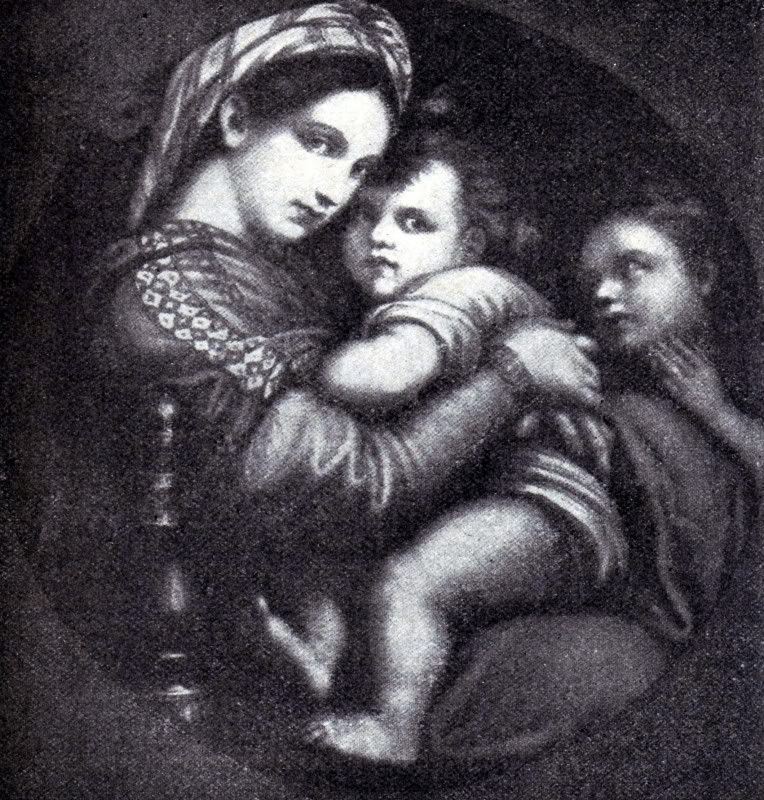
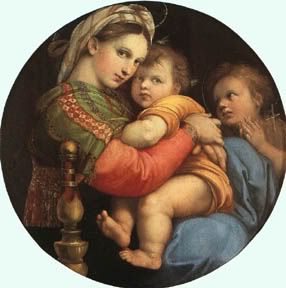
.
.
.
.
.
.
.
.
Madonna of the Chair - Raphael
“The dark background of the picture and the circular line enclosing it are symbolic of the world into which the infant Deity has come as the Light of life. The curved lines of the composition may be compared with those of the corolla of an open rose, suggestive of the beauty of Christ’s teachings. … The colors are rich and harmonious. A delicate tint of gold is seen in the drapery of the Virgin’s headdress and in the Infant’s garment which implies the pure in heart. The rose tint of the mother’s tunic is the color of love and religious devotion; while the blue symbolizes spiritual constancy and purity of soul. Nothing could be more beautiful than the serene grace and humility of the Virgin, mingled with the majesty of the infant Deity as seen in this circular picture. It is a triumph of harmony of color and line.”
.
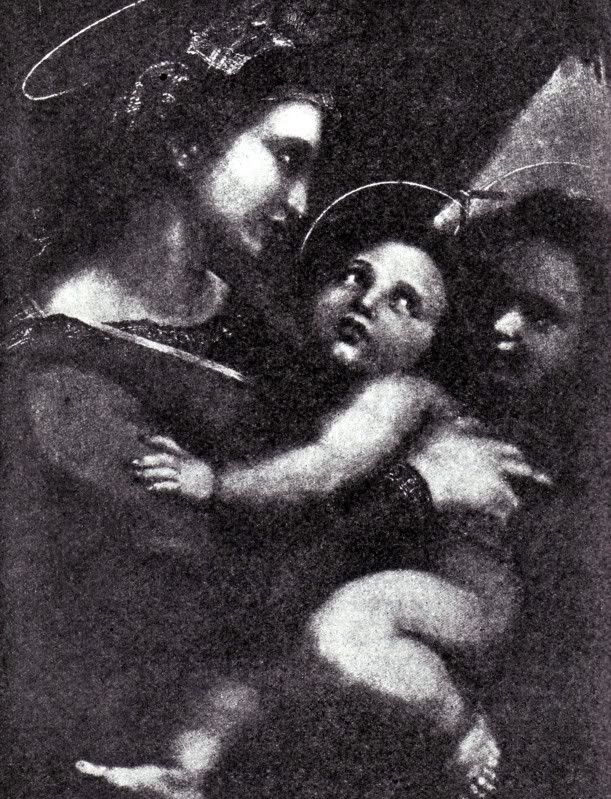
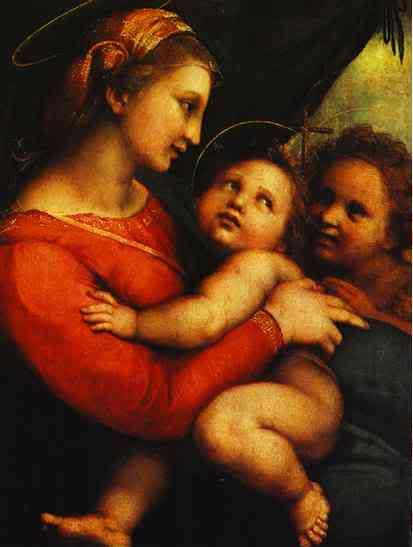
.
.
.
.
.
.
.
.
.
.
.
Madonna della Tenda - Raphael
“In this study, Mary’s face is seen in profile; it is intensely serious and beautiful. The motherly love of the Virgin and the childish innocence of the two children are most effectively expressed and contrasted. … Through the distribution of light and by the arrangement of lines the unity of the composition is secured. The infant Deity is placed in the most brilliantly lighted part of the picture; His face is the focus point; all the principal lines of the composition lead to it. The cord of the Mother’s mantle and the diagonal line of the canopy lead to this point; so do the curved lines of the Mother’s and the Infant’s arms and the upward glance of the little Saint John. The warm flesh tints of the infant Savior’s body help to make Him the center of interest. Framed in the dark background, He embodies the idea, ‘I am the light of the world; He that followeth me shall not walk in darkness, but shall have the light of life.’”
.
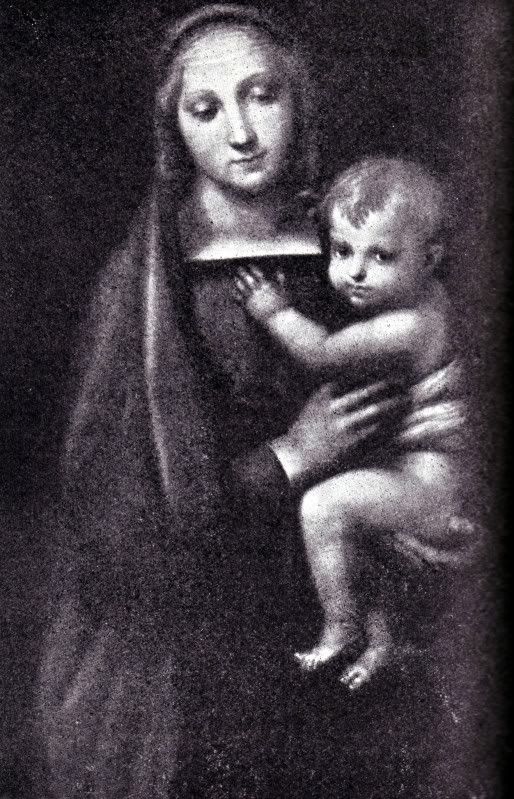
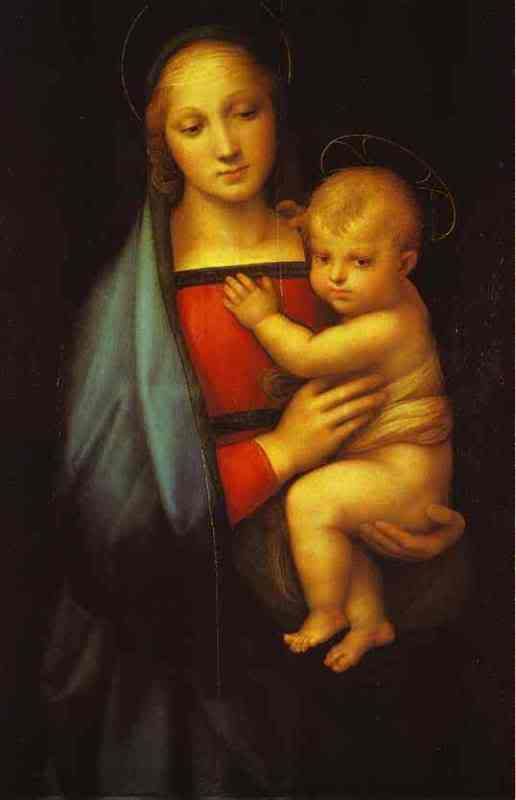
.
.
.
.
.
.
.
.
.
.
.
Madonna Granduca - Raphael
“The dress of the mother is red; her rich blue mantle is brought over her head in soft melting folds. A colored scarf is wound loosely about the body of the child.There is a fine flow in all the drapery which suggests the rhythm of poetry. A harmonious glow irradiates the composition, which partakes of a spiritual as well as a material nature. Like most of Raphael’s Madonnas, this one is not distinctively national, it is not an Italian whom he has painted, but a woman raised above what is national. The Infant Deity on the arm of His mother is quiescent, signifying peace and power. The golden lines radiating from the halo around His head take the form of a clover leaf which is the emblem of the Trinity of the Godhead. The eyes of the Virgin are thoughtful; she is looking back into her past with its divine mysteries; looking forward into a veiled but significant future. She is sublime in her serene purity and spiritual beauty. She is the Mary who has kept all these things and pondered them in her heart. Her face surrounded with hair like gold-touched mist is an echo of the delicacy and refinement of this masterpiece of color.”
.
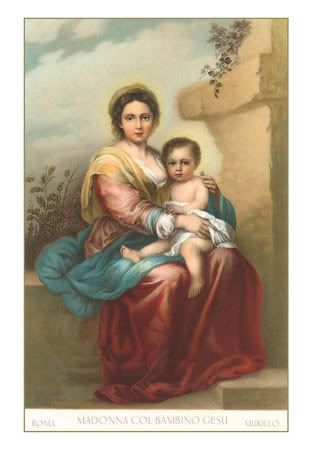

.
.
.
.
.
.
.
.
.
.
.
Madonna and Child - Murillo
“This Madonna, as well as many others which Murillo painted, has dark eyes, an olive-complexion, an expression of girlish simplicity and devout recognition of her heavenly calling. The infant in her arms is a Spanish babe full of the joy of living and with a face as fresh and radiant as flowers. The soft violet hue of the Mother’s tunic is skillfully opposed to the rich browns and golden tints of the drapery surrounding the child. … The olive branch, which is seen to the left of the Mother was used by christian artists as the symbol of peace, suggestive of Christ’s message of peace and consolation. This symbolism of the olive, founded upon its healing qualities and its oil’s well-known property of calming roughened water was borrowed from the Romans, who had themselves inherited it from older civilization as far back as the time of Noah when the dove he had sent forth from the ark returned across the waters and ‘Lo, in her mouth was an olive leaf plucked off.’ Genesis 8:11.”
.

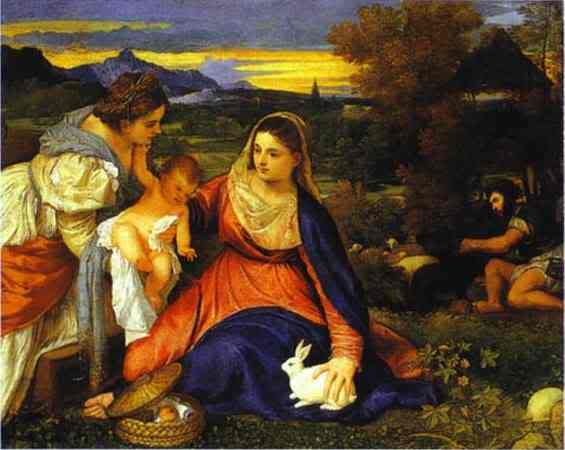
.
.
.
.
.
.
.
.
.
.
Madonna of the Rabbit - Titian
“The Arcadian sentiment is carried as far in this picture as could well be allowed. The Virgin holds a white rabbit, toward which the infant Savior, in the arms of Saint Catherine, eagerly stretches his hand. The Madonna’s attire suggests simplicity and refinement. Her head is outlined by a simple plait of light drapery, which is contrast to her dark hair produces a pleasant effect. Her blue mantle partly conceals one arm and then falls gracefully across her lap in rhythmic folds. The deep rich coloring of her dress relieves a face, gentle and innocent, with a complexion of pearly whiteness. The arrangement of Saint Catherine’s auburn hair in which a silken cord plays hide and seek is expressive of her personality. The religious expression of her face is one of traditional faith, rather than one of clear spiritual insight. Her golden brown tunic is held in at the waist with a girdle which repeats the color of her hair and forms and interesting color harmony with the mauve shade of her mantle.”
.
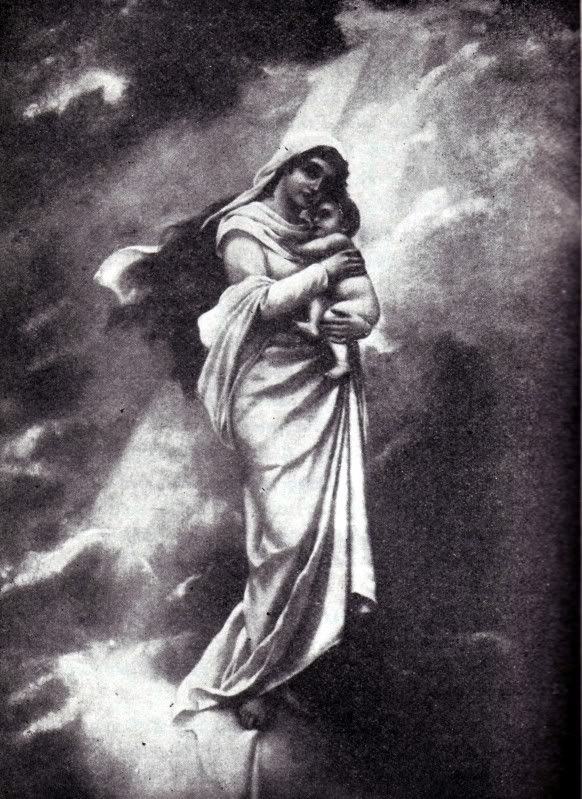
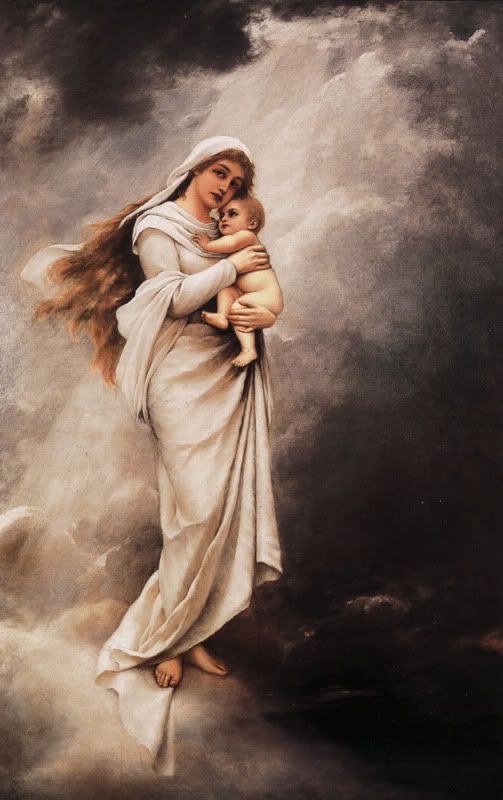
.
.
.
.
.
.
.
.
.
.
.
Madonna and Child - Bodenhausen
“More than fifteen centuries ago, the Madonna with her Babe was introduced into art and throughout all this time, the subject has been unrivalled in popularity. The reason for this is that the Madonna is the universal type of motherhood, a subject which, in its very nature, appeals to all classes of people. No one is too ignorant to understand it, and none too wise to be sueprior to its charm. Thus, century after century, the artist has poured out his soul in this all-prevailing theme of mother love until it would seem that every conceivable type was long since exhausted: but the end is not yet. So long as we have mothers, art will continue to produce Madonnas. … [This] picture was painted about 1900 and reflects the delicacy and refinement of the artist. The mother’s mood may be read at a glance; she is showing but natural affection for her child as she clasps him to her breast as if to shield him from all harm. Love is written in every lien of her face; love is the key-note of the picture. It is classed with the Madonnas of Love.”
.
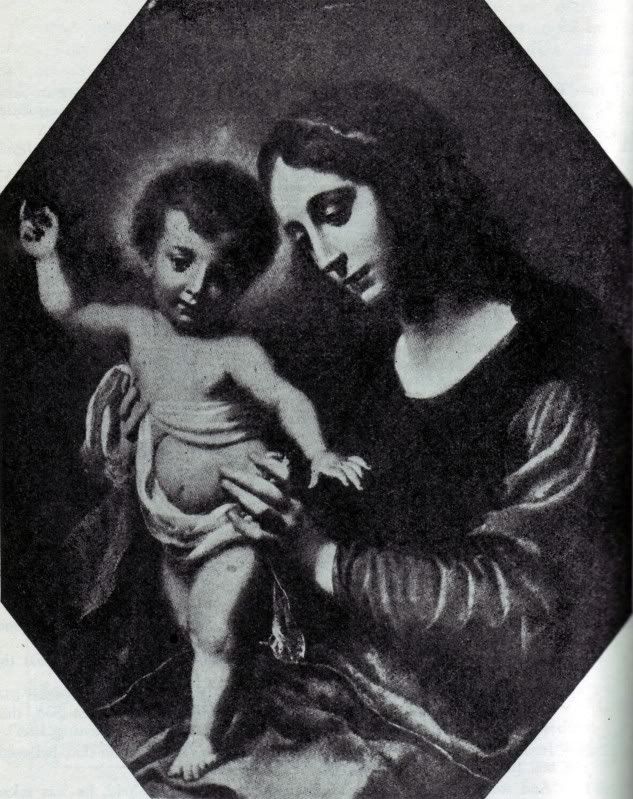
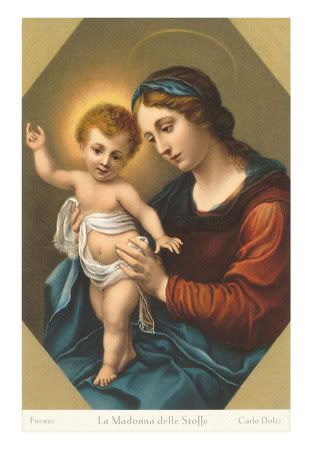
.
.
.
.
.
.
.
.
.
.
.
Madonna with the Child Jesus - Dolci
“[This] is an admirable instance of [Dolci's] poetic conception, and is an expression of harmonies in color and line. Mary’s pale and passionate face is a near approach to the Divinity enshrouded in motherhood. The flesh is so etherealized as to be but the veil for the spirit. It is an intensity of emotion, but the spirit overpowers the flesh and shines through it as moonbeams through the darkness. With one hand steetched forth and the other pointing upwards, the Infant declares his mission from on high.”
.

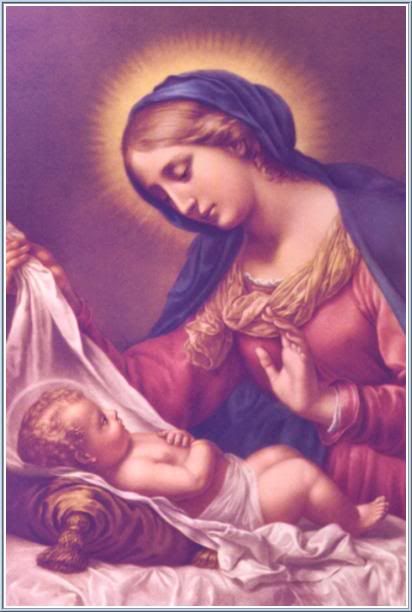
.
.
.
.
.
.
.
.
.
.
Madonna - Dolci
“Every line of the mother’s face and form is indicative of sweetness and purity. The graceful poise of the head and the position of the hands, gentle, yet strong to care for and protect, reveal the utmost delicacy of expression, which effect is heightened also by the simplicity of arrangement of the hair and dress. As she holds back the draperies and gazes yearningly upon her Son, a pathetic sadness mingles with her holy joy — a foreshadowing, perhaps, of the tragedy lying ahead. The loveliness of the Infant wins us at once. In his finely formed head and body we can see the beginnings of the strength and power of the Man to be. The rich cushion on which He lies suggests His Royalty. He seems to be responding to the look in His mother’s eyes with a sympathetic understanding of the sacred tie between them.”
.
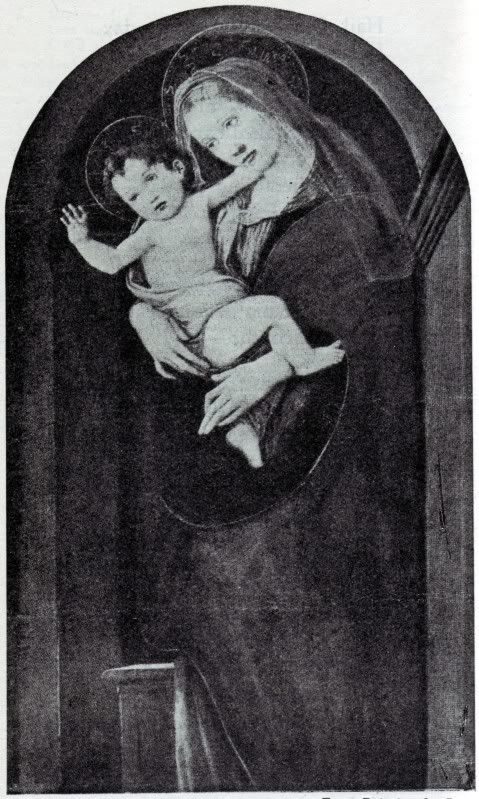

.
.
.
.
.
.
.
.
.
.
.
(Thanks to Jami and Nicole, who found this color image when I could not, after searching through dozens upon dozens of Botticelli paintings entitled simply “Madonna.” Although the background was modified in the version appearing in the Young Woman’s Journal, the poses — down to the Madonna’s crooked little finger and the babe’s funky big toe — and drapery of the figures are the same, and I’m sure this is the original source of the magazine’s modified engraving. I’m guessing that the magazine’s engraving was even made from a student or commercial copy, rather than the original. Thanks!)
Madonna and Child - Botticelli
“Botticelli was a painter of the soul of woman in all its delicate refinement, melancholy reveries, exquisite tenderness and sympathy. His Madonnas stand for peace, faith, hope, love; for all that is fairest, purest, and noblest. In this study of Mary, the Virgin’s features are delicate in outline, the forehead, bare and high. The transparent veil of white muslin which covers, without concealing, her golden hair, falls in rhythmic folds, while the powdered aureole on her head forms an agreeable substitute for the usually solid nimbus. After admiring the wealth of ideas and the depth of conceptions which the artist has put into the picture, the intrinsic beauty of mother and child alone suffices to fascinate and delight us. The dreamy and religious look of the Madonna, the preternatural seriousness of the Divine Child suggest a sort of immortality of life.”
.
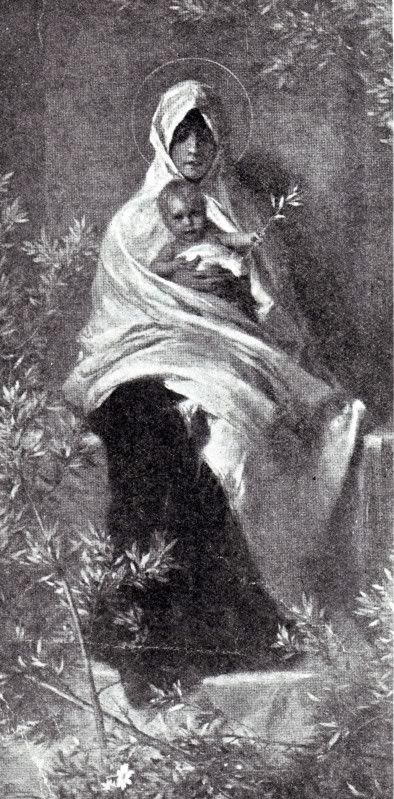
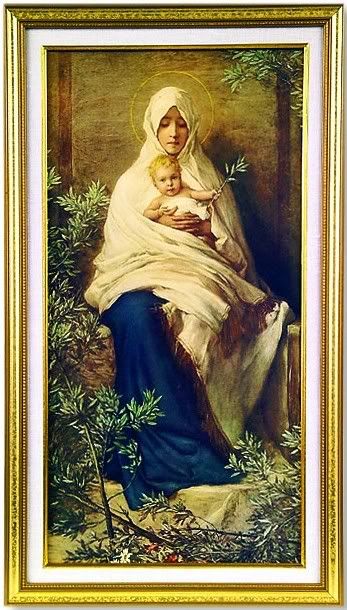
.
.
.
.
.
.
.
.
.
.
.
.
Madonna of the Olive Branch - Barabino
“This famous painting, The Madonna of the Olive Branch, reflects the richness of maturity. It was completed and exhibited in Venice just four years before the death of the artist. The picture contains only two figures: those of the Madonna and the child. The mother is shrouded in a fringed scarf of white silk which is brought over the head, fastened under the chin, and crossed over the lap. The child’s body is hidden beneath the folds of the mother’s wrap. The tunic beneath is black, while the tapestry which forms the background is of pale lilac embroidered with gold. The only other color used is the green of the olive branches which is the ancient symbol of peace, and here proclaims Him the bringer of divine peace. The dim halo of gold encircling the head of the virgin is the breath of supernatural endowments which lifted her above the angels and men. The figures are both life-size. The painting is encased in a frame of dull gilt with olive branches embossed upon it, and is hung against a wall which is covered with olive damask.”
.
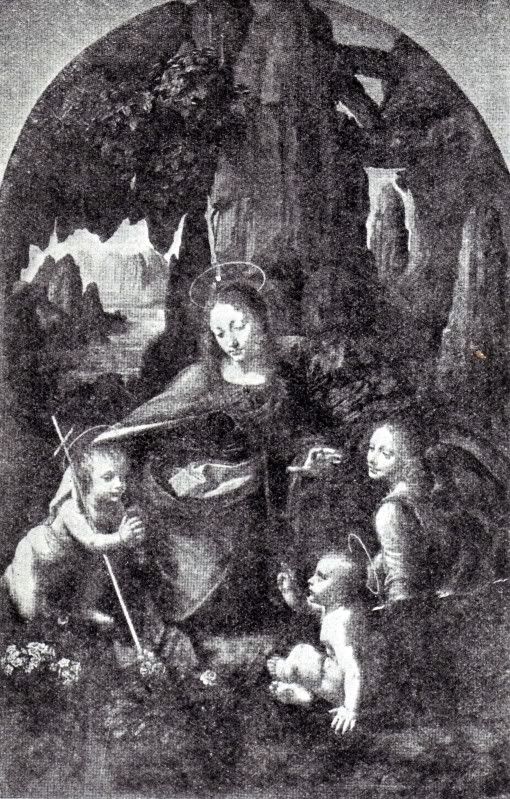

.
.
.
.
.
.
.
.
.
.
.
Madonna of the Rocks - Leonardo
“A grotto of basaltic rocks shelters the divine group, which is sitting on the margin of a clear spring, in the transparent depth of which we see the pebbles of its bed. Through the arcade of the grotto, we discover a rocky landscape, with a few scattered trees, and crossed by winding stream, on the banks of which rises a village. All is seen as through a veil of shadowy mist, less visible to eye-sight than to soul-sight. The oval faces of the Virgin and Angel, with broad high foreheads, dreamy eyes beneath drooping lids, a smile very sweet and a little sad, with a suggestion of conscious superiority, are especially Da Vinci’s. … With folded hands, the infant John acknowledges in Christ a superior power and expresses adoration for him. The red cross symbolizes the mission of Saint John as the forerunner of Christ. Leonardo searched nature for her mysteries, likewise he scanned the faces of people to discover the inward beauty that was mirrored in the outward. He was not the first to use the principle of light and shade in painting but he was the first to make it a source of poetical and emotional effect.”
.
Related images: LDS magazine covers featuring Madonnas, previously posted on Keepa:
The Virgin Mary Adoring the Infant Christ - Corregio
Madonna and Child - Crivelli
The Madonna - De Champaigne
Madonna and Child - Sichel
Madonna and Child - Lippi
La Madonnina - Ferruzzi
Rest on the Flight into Egypt - David
Virgin and Child - Murillo
Vierge a la Grappe - Mignard
Madonna and Child - Ghirlandaio
Madonna - Dolci
Continue reading at the original source →



